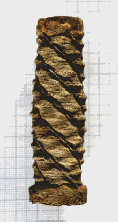Introduction
Archaeological
wood can only survive in anaerobic wet or very dry
conditions. If waterlogged wood is allowed
to dry out, surface tension forces cause the wood to collapse and the
artefact to
crumble. Traditionally impregnation with polymers followed by air or
freeze drying has been used to conserve such artefacts but this is a
very slow
process (months) and the polymers used enhance iron corrosion meaning
that
composite artefacts cannot be conserved. We have introduced "Super
critical
drying" of the wooden artefacts. The water in the artefact is first
replaced with methanol and the methanol is then extracted with
supercritical CO2.
Excellent results are obtained in terms of dimensional stability and
the process can be completed in a few days rather than several months.
It
is compatible with iron and we have successfully conserved composite
artefacts consisting of wood, iron, cloth and copper. A rapier handled
conserved
using the technique is shown in Figure 1.
 Figure 1.
Rapier handle from The
Swan
Ruben Duque 2011.
All rights reserved
|